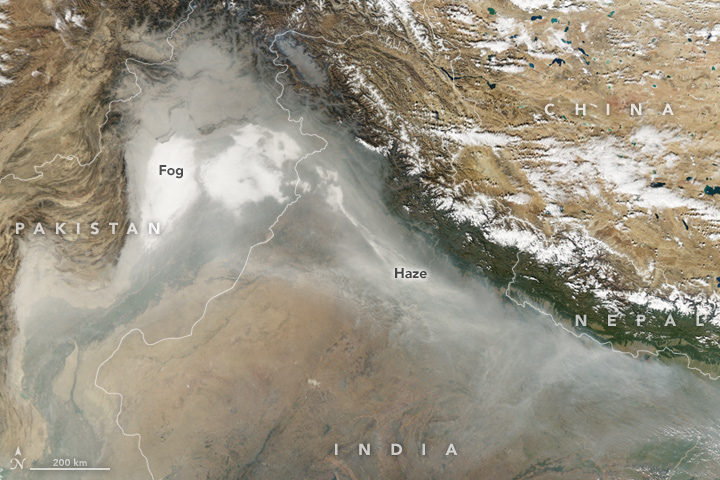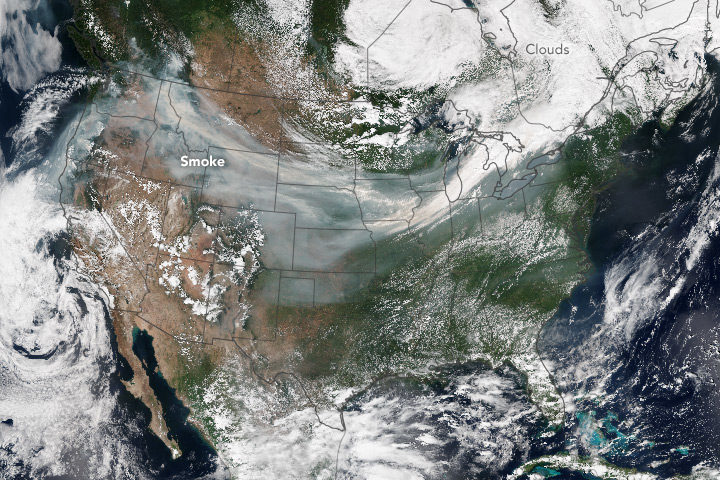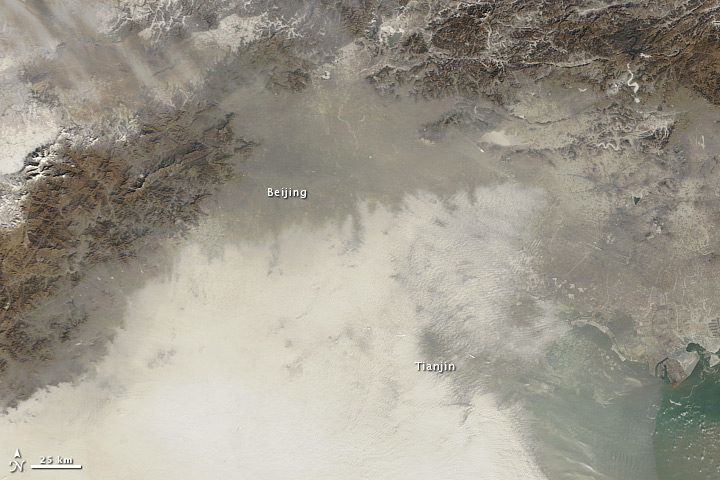

Aerosol: A collection of microscopic particles, solid or liquid, suspended in a gas. They drift in Earth’s atmosphere from the stratosphere to the surface and range in size from a few nanometers—less than the width of the smallest viruses—to several several tens of micrometers—about the diameter of human hair. Despite their small size, they have major impacts on climate and health.
Different specialists describe the particles based on shape, size, and chemical composition. Toxicologists refer to aerosols as ultrafine, fine, or coarse matter. Regulatory agencies, as well as meteorologists, typically call them particulate matter—PM2.5 or PM10, depending on their size. In some fields of engineering, they’re called nanoparticles. Everyday terms that hint at aerosol sources, such as smoke, ash, haze, dust, pollution, and soot are widely used as well.
Climatologists typically use another set of labels that speak to the chemical composition. Key aerosol groups include sulfates, organic carbon, black carbon, nitrates, mineral dust, and sea salt. In practice, many of these terms are imperfect, as aerosols often clump together to form complex mixtures. It’s common, for example, for particles of black carbon from soot or smoke to mix with nitrates and sulfates, or to coat the surfaces of dust, creating hybrid particles.
Satellite Imagery of Aerosols:

Smoke and haze in the Indo-Gangetic Plain. (NASA Earth Observatory image by Joshua Stevens, using data from the Land Atmosphere Near real-time Capability for EOS.)

A smoke plume spans the United States. (NASA Earth Observatory image by Jesse Allen, using VIIRS data from the Suomi National Polar-orbiting Partnership.)
Aerosols in the News:
Air Quality Suffering in China, NASA Earth Observatory
Tracking Dust Across the Atlantic, NASA Earth Observatory
Where to Learn More?
Tiny Particles, Big Impact
Aerosols as explained by the IPCC
Aerosols and Climate Change
Read the Alphabet from Space
A is for aerosols altering an astronaut’s view of an ancient assemblage of rock in a state adjacent to Arizona!

About this Glossary
There are other glossaries out there, but there aren’t many visual earth science glossaries, particularly those with a focus on satellite imagery. To fill that gap, Earth Matters is working on building its own. Have suggestions for what we should include? Comment on a post or send us an email.

Haze over northeastern China on January 14, 2013. Image by NASA Earth Observatory, using data Terra MODIS data from LANCE MODIS Rapid Response.
In the winter of 2013, thick haze enveloped northern China for several weeks. On January 12, 2013, the peak of that bad-air episode, the air quality index (AQI) rose to a staggering 775—off the U.S. Environmental Protection Agency scale—according to a U.S. air quality sensor in Beijing.
Extra pollution from cars, homes, and factories in the winter often sets the stage for outbreaks of air pollution in China. But a March 2017 study in Science Advances suggests that a loss of Arctic sea ice in 2012 and increased Eurasian snowfall the winter before may have helped fuel the extreme event.
Snow and ice cover can affect weather patterns because both affect albedo, a measure of how much solar radiation the surface reflects in comparison to how much incoming solar radiation it receives. In September 2012, sea ice covered less area than at any other time since 1979. Meanwhile, Eurasia had unusually high snow cover in December 2012, the second most on a record that dates back to 1967.
Normally, winds blow air pollution away from eastern China, which is home to Beijing and several other large cities. But in January 2013, winds died down to a whisper and air pollution piled up. By analyzing decades of data collected by ground-based weather stations, 15 years of satellite data on aerosols, and computer simulations of the atmosphere, the researchers concluded that unusual sea ice and snow conditions triggered a shift in China’s winter monsoon, stilling the winds that normally ventilate Beijing.
A press release from Georgia Tech explained the connection in more detail:
“The reductions in sea ice and increases in snowfall have the effect of damping the climatological pressure ridge structure over China,” explained Yuhang Wang. “That flattens the temperature and pressure gradients and moves the East Asian Winter Monsoon to the east, decreasing wind speeds and creating an atmospheric circulation that makes the air in China more stagnant.”
If correct, this might explain why efforts to reduce air pollution in recent years have not stopped extreme haze events from happening. “Emissions in China have been decreasing over the last four years, but the severe winter haze is not getting better,” said Wang. “Mostly, that’s because of a very rapid change in the high polar regions.”
This is not the first study that connects changes in the Arctic to severe haze in China. Research published in August 2015 in Atmospheric Oceanic Science Letters argued that a decline in Arctic sea ice intensifies haze in eastern China. And a study published in Nature Climate Change in April 2017 came to a similar conclusion. The latter study projected a 50 percent increase in the frequency of extreme haze events and an 80 percent increase in their persistence in the near future.